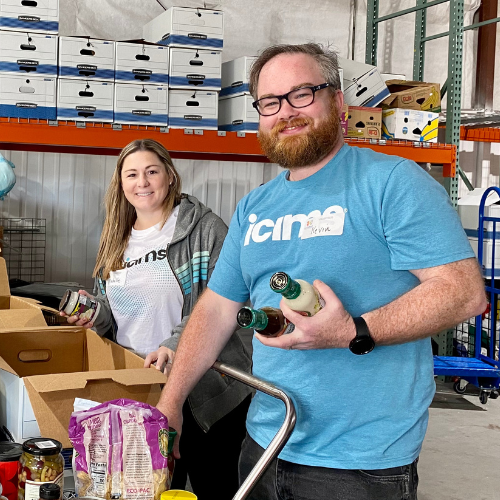- Solutions
- Products
- Community
- Resources
- Company
Create incredible candidate experiences that communicate your brand, mission, and values with recruitment marketing solutions.
Learn moreCommunicate effectively and efficiently with the candidates that can drive your business forward.
Learn moreSelect the right candidates to drive your business forward and simplify how you build winning, diverse teams.
Learn moreHelp your best internal talent connect to better opportunities and see new potential across your entire organization.
Learn moreCommunicate collectively with large groups of candidates and effectively tackle surges in hiring capacity.
Learn moreAccess tools that help your team create a more inclusive culture and propel your DEI program forward.
Learn moreRebound and respond to the new normal of retail with hiring systems that are agile enough to help you forge ahead.
Learn moreAccelerate the hiring of key talent to deliver point of care and support services that meet and exceed your promise of patient satisfaction.
Learn moreAttract and engage candidates with technical competencies, accelerate hiring for much-needed skills, and advance expertise within your valued workforce.
Learn moreSimplify how you recruit finance, insurance, and banking candidates with a unified platform built to match top talent with hard-to-fill roles.
Learn moreYour business strategy depends on your people strategy. Keep both in lockstep with the iCIMS Talent Cloud.
Learn moreBuild an engaging, high-converting talent pipeline that moves your business forward.
Learn moreDeliver the innovation your talent team needs, along with the global scale and security you demand.
Learn moreDeliver tailored technology experiences that delight users and power your talent transformation with the iCIMS Talent Cloud.
Learn moreThe #1 ATS in market share, our cloud-based recruiting software is built for both commercial and large, global employers.
Learn more Talk to salesAttract the best talent for your business with powerful, on-brand career websites that excite candidates and drive engagement.
Learn more Talk to salesBuild talent pipelines, engage candidates with multi-channel marketing campaigns, and use machine learning to automatically surface the right talent for the job.
Learn more Talk to salesEmpower candidates with automated self-service, qualification screening, and interview scheduling through an AI-enabled digital assistant.
Learn more Talk to salesSimplify employee onboarding with automated processes that maximize engagement and accelerate productivity.
Learn more Talk to salesCompliment your sourcing and engagement efforts with award-winning lead scoring and advanced campaign personalization.
Learn more Talk to salesImprove employee experience, retention, and reduce internal talent mobility friction with the iCIMS Opportunity Marketplace.
Learn more Talk to salesVerify skills with game-changing levels of automation and simplicity to improve the quality of hire at scale.
Learn more Talk to salesModernize, streamline, and accelerate your communication with candidates and employees.
Learn more Talk to salesTransform the talent experience by showcasing your authentic employer brand through employee-generated video testimonials.
Learn more Talk to salesGet robust analytics that help you make sense of your data and illuminate your talent pool.
Learn moreSimplify recruiting, dynamically engage talent, and reduce hiring bias with job matching and recruiting chatbot technology.
Learn more Talk to salesGet exclusive intel on industry and market trends along with expert one-on-one advice.
Learn more Talk to salesThe #1 ATS in market share, our cloud-based recruiting software is built for both commercial and large, global employers.
Learn more Talk to salesAttract the best talent for your business with powerful, on-brand career websites that excite candidates and drive engagement.
Learn more Talk to salesBuild talent pipelines, engage candidates with multi-channel marketing campaigns, and use machine learning to automatically surface the right talent for the job.
Learn more Talk to salesEmpower candidates with automated self-service, qualification screening, and interview scheduling through an AI-enabled digital assistant.
Learn more Talk to salesSimplify employee onboarding with automated processes that maximize engagement and accelerate productivity.
Learn more Talk to salesCompliment your sourcing and engagement efforts with award-winning lead scoring and advanced campaign personalization.
Learn more Talk to salesImprove employee experience, retention, and reduce internal talent mobility friction with the iCIMS Opportunity Marketplace.
Learn more Talk to salesVerify skills with game-changing levels of automation and simplicity to improve the quality of hire at scale.
Learn more Talk to salesModernize, streamline, and accelerate your communication with candidates and employees.
Learn more Talk to salesTransform the talent experience by showcasing your authentic employer brand through employee-generated video testimonials.
Learn more Talk to salesGet robust analytics that help you make sense of your data and illuminate your talent pool.
Learn moreSimplify recruiting, dynamically engage talent, and reduce hiring bias with job matching and recruiting chatbot technology.
Learn more Talk to salesGet exclusive intel on industry and market trends along with expert one-on-one advice.
Learn more Talk to salesHow a beloved restaurant hires 40,000+ annually with a great candidate experience.
Learn moreThousands strong, our global community of talent professionals includes creatives, innovators, visionaries, and experts.
Learn moreTogether we’re creating the world’s largest ecosystem of integrated recruiting technologies.
Learn moreExplore our network of more than 300 certified, trusted third-party service and advisory partners.
Learn moreUncover unique market insights, explore best practices and gain access to talent experts across out library of content.
Get resourcesExpert guidance about recruitment solutions, changes in the industry, and the future of talent.
Learn moreStay up to date with the latest terminology and verbiage in the HR software ecosystem.
Learn moreEmployers everywhere improve hiring efficiently and save money using iCIMS. Estimate the potential business value you can achieve.
Learn moreDive into the Class of 2023 Report highlighting this cohort’s expectations and where employers are willing — and able — to meet them.
Watch nowPartner with iCIMS to build the right strategies, processes, and experience to build a winning workforce.
Learn moreExpert guidance about recruitment solutions, changes in the industry, and the future of talent.
Learn moreThe iCIMS Talent Cloud delivers a secure, agile, and compliant platform designed to empower talent teams, job seekers, and partners with advanced data protection and privacy.
Learn moreView press releases, media coverage, and the latest hiring data. See what analysts are saying about iCIMS.
Learn moreiCIMS is the Talent Cloud company that empowers organizations to attract, engage, hire, and advance the talent that builds a winning workforce.
Learn moreGet to know the award-winning leadership team shaping the future of the recruiting software industry.
Learn moreWe believe the future of work isn't something that "happens" to you. It's something you create. We actively create the future of work with our customers every day.
Learn moreiCIMS is committed to being a responsible and ethical corporate citizen, which is why Environmental, Social and Governance (ESG) initiatives are strategic imperatives.
Learn moreStreamline your tech stack and take advantage of a better user experience and stronger data governance with ADP and the iCIMS Talent Cloud.
Learn moreThe combined power of iCIMS and Infor helps organizations strategically align their business and talent objectives.
Learn moreOur award-winning partnership with Microsoft is grounded in a shared desire to transform the workplace and the hiring team experience.
Learn moreOur partnership with Ultimate Kronos Group (UKG) supports the entire talent lifecycle by bringing frictionless recruiting solutions to UKG Pro Onboarding.
Learn moreLet’s get in touch. Reach out to learn more about iCIMS products and services.
Learn more

The future of work is here.
It is safe to say that how companies engage, hire, and retain talent will never be the same. While many organizations are currently re-evaluating their recruitment processes, Amazon, Uber Eats, Domino’s, and 7-Eleven were able to quickly staff up throughout the first several months of the pandemic. What Amazon and the like all have in common is that they prioritized recruiting technology investments that gave them the ability to be remote-ready overnight.
Today, a business’ success is dependent on their ability to build a diverse and well-rounded workforce. HR and IT leaders can work together to ensure they have the tools they need to virtually source, engage, hire, and onboard the people they need to continue accommodating short-term needs, while also supporting long-term business success.
Here are steps you can take to do the same:
1. Identify your biggest challenges. Evaluate your current hiring process and pinpoint any major gaps that have slowed you down in filling open roles.
These are all common stopgaps in the hiring process that can be addressed with the right combination of technology and people.
2. Get the right people involved. This is critical to your organization’s ability to effectively roll out a new technology. In fact, we recently conducted a study of 500 IT and HR operations executives to better understand common challenges around digital transformation, and found that a major issue is that HR and IT departments often have misaligned priorities. Talent acquisition and HR leaders should work hand-in-hand with their IT counterparts throughout this entire process to avoid any unnecessary delays.
When working with decision-makers, focus on a solution’s implementation requirements, scalability, ease-of-use and integration capabilities – all top criterion when evaluating new providers, according to our study.
3. Test and communicate – on repeat. Once the new technology is in place, test it on several occasions, accounting for any and all unique circumstances. Over the past several months, we’ve seen this work not only in our organization’s favor, but in many of our customers’ favor, as they were ready to transition to a remote work model, having previously ensured that their systems were capable of supporting this new reality.
It’s also imperative that when new technology is adopted, all employees across the organization are made aware and understand what their role is. Send out a regular stream of communication from the onset of the implementation phase so the entire staff feels involved and is up to date on progress.
Recently, our company rolled out Microsoft Teams to replace a couple of different communication platforms. To gain buy-in and feedback, our tech team set up a beta program in advance for early adopters to play in. Later, when it was transitioned to the whole company, tech services held drop-in sessions to answer questions and walk individuals through different features. The result was a quick adoption and an increase in productivity and efficiency of communication – and that translates to happier teams.
4. Ask for feedback and be quick to adjust. It’s important for a company to not only ask all affected employees and new hires for their feedback on any new technology that is implemented, but to quickly adapt their strategy or revise technology solutions based on that feedback. Whether you collect your team’s thoughts in a survey, via email, or simply during virtual meetings, there is nothing more valuable than the opinion of those using the technology in their day-to-day work.
Leverage this intel when working with your vendor to make any necessary tweaks in order to maximize your investment and better serve those using the technology.
Leaders continue to prepare for the imminent upswing that is around the corner. And those new future of work plans will include investing in the people and technology needed to build a winning workforce. Virtual hiring doesn’t just apply to thriving today, it is what will carry your organization through the future.
and receive free tips on how to attract, engage, hire, & advance the best talent.





